
The Battle of Ba Gia was a major battle that marked the beginning of the Viet Cong's (VC) Summer Offensive of 1965, during the early phases of the Vietnam War. The battle took place in Quảng Ngãi Province, South Vietnam, between May 28–31, 1965.
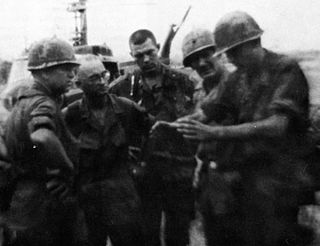
The Battle of Ong Thanh was fought at the stream of that name on the morning of 17 October 1967, in Chơn Thành District, at the time part of Bình Dương Province, South Vietnam, today in Bình Phước Province.

The Battle of Lộc Ninh was a major battle fought during the Easter Offensive during the Vietnam War, which took place in Bình Long Province, South Vietnam between 4 and 7 April 1972. Towards the end of 1971, North Vietnamese leaders decided to launch a major offensive against South Vietnam, with the objective of destroying Army of the Republic of Vietnam (ARVN) units and capturing as much territory as possible, in order to strengthen their bargaining position in the Paris Peace Accords. On 30 March 1972, two People's Army of Vietnam (PAVN) divisions smashed through the Vietnamese Demilitarized Zone, marking the commencement of the Easter Offensive. They quickly overwhelmed South Vietnamese units in the I Corps Tactical Zone. With the rapid collapse of South Vietnamese forces in the northern provinces of South Vietnam, PAVN and Viet Cong (VC) forces began preparing for their next offensive, targeting Bình Long Province in the rubber plantation region north of Saigon. On 4 April, the VC 5th Division opened their attack on Lộc Ninh, defended by the ARVN 9th Infantry Regiment. After three days of fighting, the vastly outnumbered ARVN forces, though well supported by American air power, were forced to abandon their positions in Lộc Ninh.
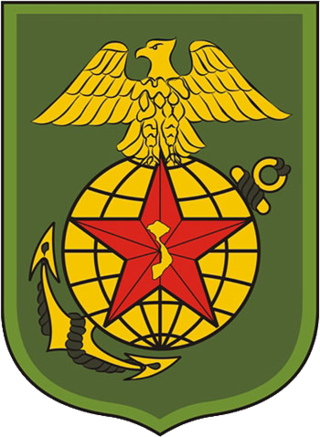
The Republic of Vietnam Marine Division was part of the armed forces of South Vietnam. It was established by Ngo Dinh Diem in 1954 when he was Prime Minister of the State of Vietnam, which became the Republic of Vietnam in 1955. The longest-serving commander was Lieutenant General Le Nguyen Khang. In 1969, the VNMC had a strength of 9,300, 15,000 by 1973, and 20,000 by 1975.

The First Battle of Loc Ninh took place during the Vietnam War that occurred between 29 October and 7 November 1967, fought by the Viet Cong, Army of the Republic of Vietnam (ARVN), Civilian Irregular Defense Group and the United States Army.
Operation Atlanta was a road security operation in Đồng Nai Province carried out by the 11th Armored Cavalry Regiment from 19 October to December 1966 during the Vietnam War and was the first major combat operation of the 11th ACR in the war.

The Fifth Division of the Army of the Republic of Vietnam (ARVN)—the army of the nation state of South Vietnam that existed from 1955 to 1975—was part of the III Corps that oversaw the region of the country surrounding the capital, Saigon.
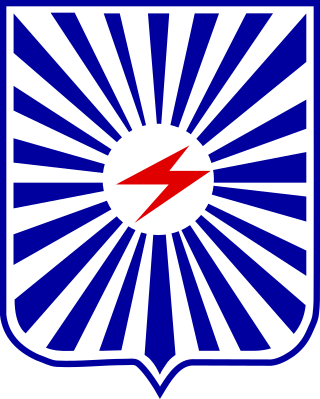
The 21st Division of the Army of the Republic of Vietnam (ARVN)—the army of the nation state of South Vietnam that existed from 1959 to 1975, was part of the IV Corps that oversaw the southernmost region of South Vietnam, the Mekong Delta. The 21st Division was based in Chương Thiện Province, the southernmost province in the whole country, in an area dominated by jungles and swamps.

The Vietnamese Airborne Division or VNAD was one of the earliest components of the Republic of Vietnam Military Forces. The Vietnamese Airborne Division began as companies organized in 1948, prior to any agreement over armed forces in Vietnam. After the partition of Vietnam, it became a part of the Army of the Republic of Vietnam. This division had its distinct origins in French-trained paratrooper battalions, with predecessor battalions participating in major battles including Dien Bien Phu and retained distinct uniforms and regalia. With the formation of an independent republic, the colonial paratroopers were dissolved, however regalia and aesthetics alongside the nickname "Bawouans" would be retained.

The Battle of Suoi Bong Trang was an engagement fought between US, Australian and New Zealand forces, and the Viet Cong and North Vietnamese Army during the Vietnam War. The battle occurred during Operation Rolling Stone, an American security operation to protect engineers building a tactically important road in the vicinity of Tan Binh, in central Binh Duong Province, 30 kilometres (19 mi) north-west of Bien Hoa airbase. During the fighting, soldiers from the US 1st Brigade, 1st Infantry Division and the 1st Battalion, Royal Australian Regiment, which had been attached for the operation, fought off a regimental-sized Viet Cong night assault. Repulsed by massed firepower from artillery and tanks, the Viet Cong suffered heavy casualties and were forced to withdraw by morning. After the attack, the Americans and Australians made no attempt to pursue the Viet Cong, focusing on securing the battlefield and evacuating their own casualties. The Viet Cong continued to harass the American sappers with occasional sniper and mortar fire, but these tactics proved ineffective, and the road was completed by 2 March.

Operation Truong Cong Dinh, was a United States and Army of the Republic of Vietnam (ARVN) security operation to reestablish South Vietnamese control over the northern Mekong Delta in the aftermath of the Tet Offensive. The operation aimed to root out Viet Cong (VC) forces in the area, and to stop them from attacking traffic on the nearby Highway 4.
The second battle of Bàu Bàng occurred during the night of 19–20 March 1967 during Operation Junction City, a search and destroy mission by American military forces in Tay Ninh Province of South Vietnam, to the west of the capital Saigon.

Operation Crazy Horse, named after Lakota warrior Crazy Horse, was a search and destroy mission during the Vietnam War conducted by military forces of the United States, South Vietnam, and the Republic of South Korea in two valleys in Bình Định Province of South Vietnam.
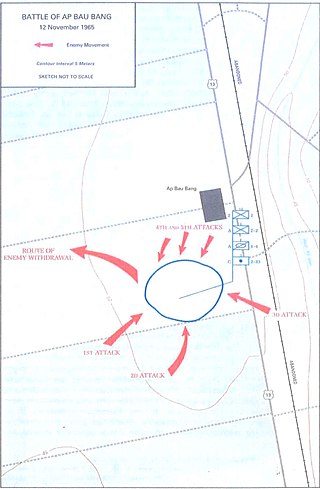
The Battle of Ap Bau Bang took place on the morning of 12 November 1965 when two regiments from the Viet Cong (VC) 9th Division attacked a night defensive position of the United States 2nd Battalion, 2nd Infantry Regiment at a small village (ấp) of Bàu Bàng, in today's Bàu Bàng district, 25 km north of Thủ Dầu Một.
Operation El Paso and Operation El Paso II were operations conducted during the Vietnam War by the U.S. Army's 3rd Brigade of the 1st Infantry Division in Bình Long Province, lasting from 19 May to 13 July 1966.
Operation Shenandoah was an operation conducted by 1st Brigade, 1st Infantry Division in Bình Long Province, lasting from 16 October to 2 November 1966.
Operation Amarillo was an operation conducted by 1st Brigade, 1st Infantry Division in Bình Dương Province, lasting from 23–31 August 1966.
Operation Shenandoah II was a security operation conducted during the Vietnam War by the U.S. 1st Infantry Division to secure and repair Highway 13, South Vietnam from 29 September to 19 November 1967.
Phase III of the Tet offensive of 1968 was launched by the People's Army of Vietnam (PAVN) and Viet Cong (VC) from 17 August to 27 September 1968. The offensive was divided into two waves of attacks from 17 to 31 August 1968 and from 11 to 27 September of that same year.
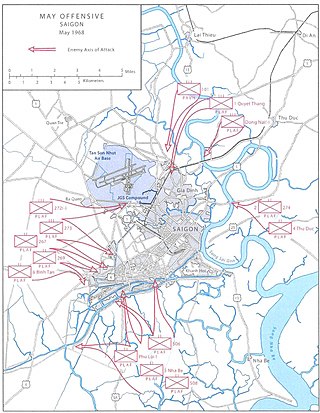
The Battle of West Saigon took place from 5–12 May 1968 during the May Offensive of the Vietnam War as South Vietnamese and United States forces countered the main thrust of the offensive against the western suburbs of Saigon.













